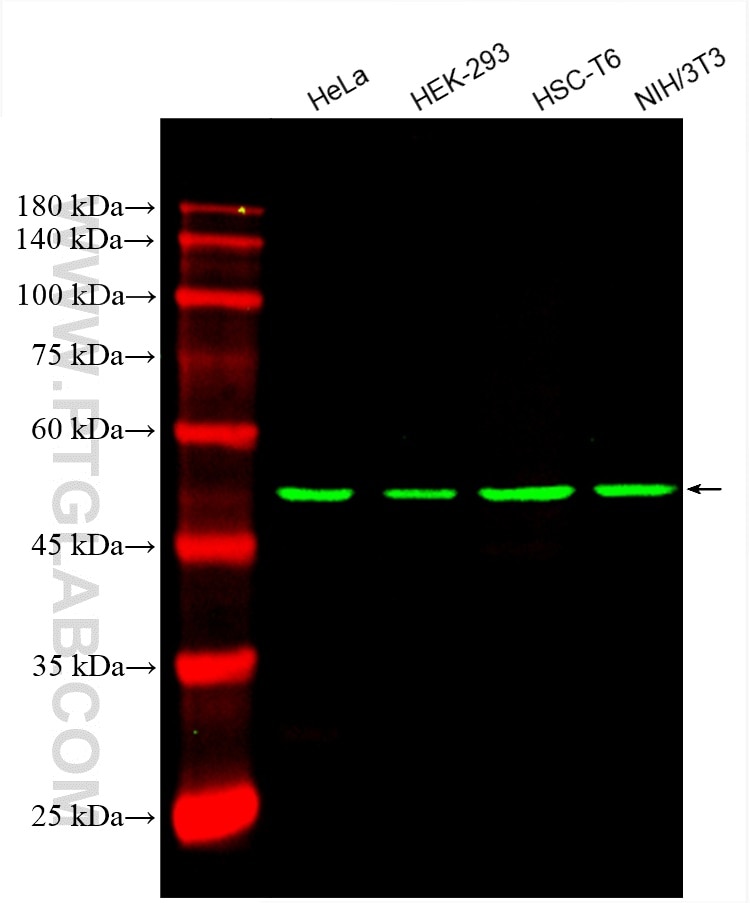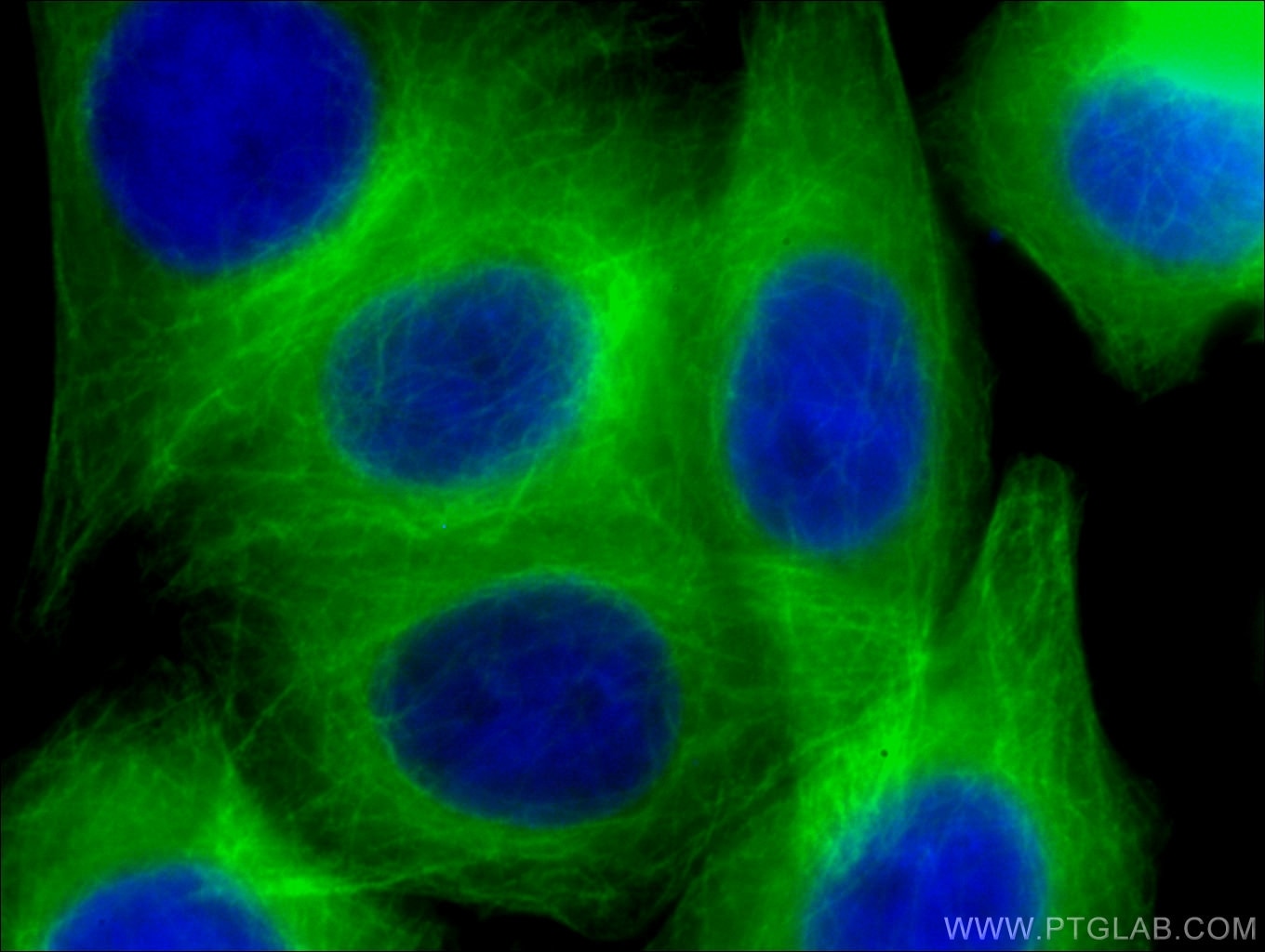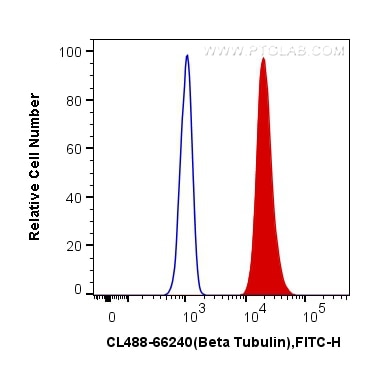Beta Tubulin Monoklonaler Antikörper
Beta Tubulin Monoklonal Antikörper für FC (Intra), IF, WB
Wirt / Isotyp
Maus / IgG2a
Getestete Reaktivität
Hausschwein, human, Maus, nematode, Ratte, Zebrafisch
Anwendung
WB, IF, FC (Intra)
Konjugation
CoraLite® Plus 488 Fluorescent Dye
CloneNo.
1D4A4
Kat-Nr. : CL488-66240
Synonyme
Galerie der Validierungsdaten
Geprüfte Anwendungen
| Erfolgreiche Detektion in WB | HeLa-Zellen, HEK-293-Zellen, NIH/3T3-Zellen |
| Erfolgreiche Detektion in IF | HepG2-Zellen |
| Erfolgreiche Detektion in FC | HeLa-Zellen |
Empfohlene Verdünnung
| Anwendung | Verdünnung |
|---|---|
| Western Blot (WB) | WB : 1:2000-1:10000 |
| Immunfluoreszenz (IF) | IF : 1:50-1:500 |
| Durchflusszytometrie (FC) | FC : 0.40 ug per 10^6 cells in a 100 µl suspension |
| It is recommended that this reagent should be titrated in each testing system to obtain optimal results. | |
| Sample-dependent, check data in validation data gallery | |
Veröffentlichte Anwendungen
| WB | See 1 publications below |
| IF | See 7 publications below |
Produktinformation
CL488-66240 bindet in WB, IF, FC (Intra) Beta Tubulin und zeigt Reaktivität mit Hausschwein, human, Maus, nematode, Ratten, Zebrafisch
| Getestete Reaktivität | Hausschwein, human, Maus, nematode, Ratte, Zebrafisch |
| In Publikationen genannte Reaktivität | human, Maus, Ratte |
| Wirt / Isotyp | Maus / IgG2a |
| Klonalität | Monoklonal |
| Typ | Antikörper |
| Immunogen | Beta Tubulin fusion protein Ag0117 |
| Vollständiger Name | tubulin, beta 3 |
| Berechnetes Molekulargewicht | 450 aa, 50 kDa |
| GenBank-Zugangsnummer | BC000748 |
| Gene symbol | TUBB3 |
| Gene ID (NCBI) | 10381 |
| Konjugation | CoraLite® Plus 488 Fluorescent Dye |
| Excitation/Emission maxima wavelengths | 493 nm / 522 nm |
| Form | Liquid |
| Reinigungsmethode | Protein-A-Reinigung |
| Lagerungspuffer | BS mit 50% Glyzerin, 0,05% Proclin300, 0,5% BSA, pH 7,3. |
| Lagerungsbedingungen | Bei -20°C lagern. Vor Licht schützen. Nach dem Versand ein Jahr stabil. Aliquotieren ist bei -20oC Lagerung nicht notwendig. 20ul Größen enthalten 0,1% BSA. |
Hintergrundinformationen
There are five tubulins in human cells: alpha, beta, gamma, delta, and epsilon. Tubulins are conserved across species. They form heterodimers, which multimerize to form a microtubule filament. An alpha and beta tubulin heterodimer is the basic structural unit of microtubules. The alpha and beta tubulins (+/- 55 kDa MW) are homologous but are not identical. Beta tubulins have been widely used as loading control.
What is the molecular weight of beta-tubulin? Are there any isoforms of beta-tubulin?
The molecular weight of tubulin is 50-52 kDa. Humans have eight beta-tubulin isotypes, encoded by different genes, that differ in their C-terminal sequences. They have different tissue expression profiles and can rise to microtubules of different properties (PMID: 20191564).
How to use beta-tubulin as a loading control
Beta-tubulin is one of the most commonly used references as a loading control for cell lysates in western blotting. It is abundantly expressed across various tissues and developmental stages and highly conserved across species. However, since some variability has been observed in the expression levels of commonly used housekeeping genes (PMID: 15627964), it is recommended that more than one loading control antibody is used while developing new assays. More information can be found here: https://www.ptglab.com/news/blog/loading-control-antibodies-for-western-blotting/.
What drugs can influence beta-tubulin and organization of microtubules?
Many drugs that affect microtubule dynamics target beta-tubulin, mainly by interfering with the GTP hydrolysis (PMID: 21381049). Paclitaxel (Taxol) is used to stabilize microtubules by slowing down their depolymerization, while colchicine and vinca alkaloids (vinblastine) destabilize microtubules. They are used in research and also in the clinic as anti-cancer agents.
Is beta-tubulin post-translationally modified?
Yes, tubulins are subject to extensive post-translational modifications (PTMs) that affect the organization of microtubules and their dynamics. The most common modifications include polyglutamylation, polyglycylation, polyamination, glycososylation, glycation, phosphorylation, and acetylation (PMID: 24801181 and 25468068).
Protokolle
| Produktspezifische Protokolle | |
|---|---|
| WB protocol for CL Plus 488 Beta Tubulin antibody CL488-66240 | Protokoll herunterladen |
| IF protocol for CL Plus 488 Beta Tubulin antibody CL488-66240 | Protokoll herunterladen |
| Standard-Protokolle | |
|---|---|
| Klicken Sie hier, um unsere Standardprotokolle anzuzeigen |
Publikationen
| Species | Application | Title |
|---|---|---|
Cell Chem Biol S1PR3-G12-biased agonist ALESIA targets cancer metabolism and promotes glucose starvation. | ||
Elife A novel mechanism of bulk cytoplasmic transport by cortical dynein in Drosophila ovary. | ||
Mol Ther Nucleic Acids Non-targeting control for MISSION shRNA library silences SNRPD3 leading to cell death or permanent growth arrest. | ||
Front Cell Dev Biol Caffeine Induces Autophagy and Apoptosis in Auditory Hair Cells via the SGK1/HIF-1α Pathway. | ||
iScience The vesicular transporter STX11 governs ATGL-mediated hepatic lipolysis and lipophagy. |





